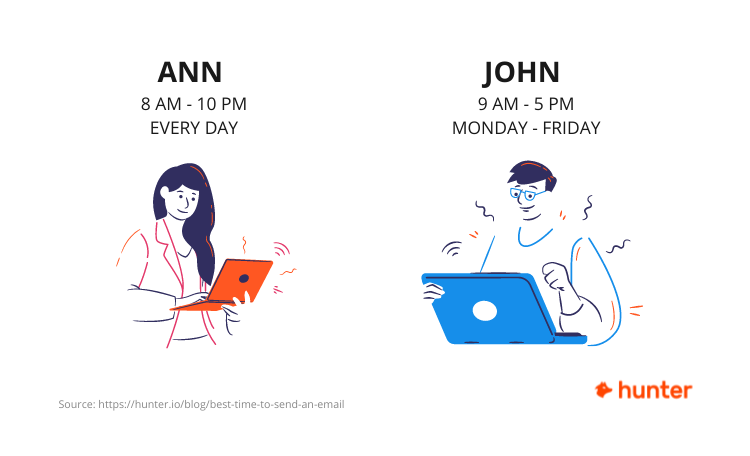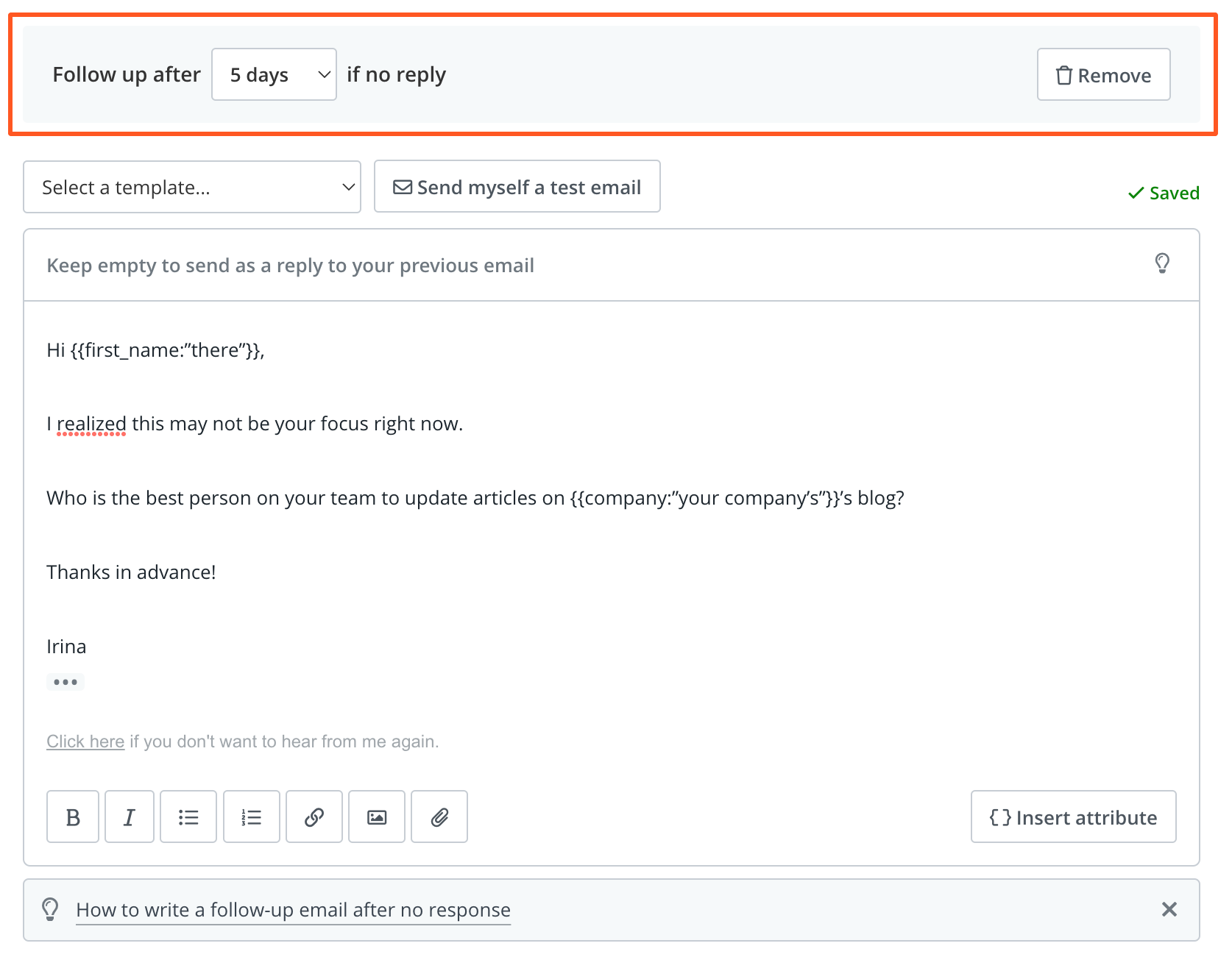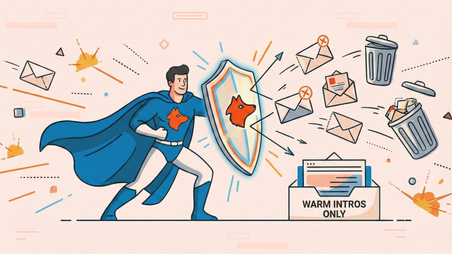The Best Time to Send an Email (What 9 Studies Say)

You've prepared the email copy and a compelling offer for your prospect. You can’t wait to hit “Send” and get a response, but you're not sure about one thing—what is the best time to send the email?
You can ask ten different marketers about this, and you’ll get ten different responses.
Does that mean that there is no perfect time to send an email? What is better for you—send it now on Wednesday at 3 PM or do it tomorrow on Thursday at noon?
Spoiler alert: It depends.
This guide will analyze the most recent studies on the best time to send an email and identify the best time to send an email for you.
Why does timing matter for email marketing?
The success of your email marketing campaigns depends on many factors—one of the important ones is your sending schedule.
No one will read your perfectly crafted pitch and get back to you if they don't open your email first (yeah, it’s that obvious).
You pick the wrong time—and your email is lost in your prospects’ inboxes.
But what does the “wrong time” actually mean?
Before checking stats and tons of data, let’s see what common sense says:
- You can expect lower open rates during the weekends, vacations, and public holidays (imagine someone is having Christmas dinner with their family, the chances are low that this person will be checking their inbox that evening);
- Monday mornings and Friday evenings could also be quite busy for some people (on Monday morning, you typically have your inbox full of emails and notifications from over the weekend that your colleagues sent; on Friday evening, you may want to finish your colossal to-do list ASAP, turn off notifications, and jump into the weekend);
- If you send emails to a massive list of people, there are chances that they live in different countries. While you’re waiting for a response, your prospect could be sleeping (the demographics matter, and we’ll talk about this more later).

These are just some apparent insights, and I’m sure you can come up with a more extensive list by thinking of your audience and what they’re doing now when you want to send them your email.
What studies say
We’ve read and analyzed the nine most prominent case studies on the best time to send an email. There are billions of B2B emails analyzed in these case studies.
These are the studies we analyzed:
- Ultimate Email Marketing Benchmarks for 2021: By Industry and Day (by Campaign Monitor)
- What Is The Best Time To Send An Email In 2021? [Data-Driven] (by Moosend)
- The Best Time To Send Email by Location - 2020 Study (by GetResponse)
- The Best Time to Send Emails (Omnised Research) (by Omnisend)
- What Our Data Told Us about the Best Time to Send Email Campaigns (by Campaign Monitor)
- Email Marketing Benchmarks (by GetResponse)
- What Our Data Says About The Best Time To Send Messages (by Intercom)
- Best Time to Send an Email: User Data Study by Industry (by Sendinblue)
- The Email Marketing Field Guide: The Best Times and Days to Send your Message and Get It Read (by Propeller)
What is the best day to send emails?
In 2021, Moosend analyzed 10 billion emails sent through their platform and found that emails sent on Thursdays had the highest open rates. Tuesday was the second best day to send emails if you want to maximize open rates. At the same time, weekends had the lowest average open rate.

GetResponse conducted similar research by analyzing over 2.85 million emails sent by their users within the first two quarters of 2020. Their data suggests that the days of the week play a minor role if you’re optimizing your campaigns for open and click-through rates, except for the weekends, when the average open rates were the lowest. There is only a slight difference between weekdays.

In GetResponse’s research, Friday was the day with the highest open rate of 20.58%, only 0.73% more than Thursday, the day with the worst open rate.
Sendinblue’s research on email engagement showed that weekdays tend to have more engagement compared to weekends. In terms of click volume, Tuesdays and Wednesdays saw the most significant amount of engagement. These days had a correspondingly high number of opens, as well.
Our takeaways:
- There is no considerable difference in open and click-through rates of the emails when they’re sent during weekdays;
- As all research confirms, it’s better not to send emails on weekends.
What is the best time to send an email?
Moosend suggests sending marketing emails between 8 AM and 9 AM; this is when they noticed the highest open rates.
At the same time, you can see that there’s no big open rate difference between emails sent during the typical 9 AM to 5 PM work hours.

Omnisend’s team, which analyzed 2 billion promotional emails sent through their platform, noticed that open rate peaks at 8 AM, 1 PM, and 4 PM.

They recommend sending marketing emails at 8 AM to maximize open rates and avoid sending emails roughly from 7 PM to 7 AM when most people are not at work.
CampaignMonitor's research showed that opens increase as people begin to wake up and start their day.
53% of email opens happen between 9 AM to 5 PM (not including lunch breaks). As you can see on the next graph, lunchtime opens drop by a fraction.

While both B2B and B2C businesses aim to have high open rates, there are slight differences between target audiences and their daily routines.
For example, if you send an email to a B2B audience, you should consider the length of the typical working day of your target persona. For B2C audiences, the patterns are much different, so you might find it helpful to schedule your email campaigns based on your buyer personas and their routines.
Our takeaways:
- As most of the research focused on B2B, you can see that the best time to send an email is during working hours;
- Emails sent in the first part of the day have a slightly higher chance to be opened;
- Don’t send emails at night when your prospects are sleeping (however, a massive chunk of those emails might be opened in the morning, during the “peak” open hours).
What experts say
We asked industry leaders who send tons of emails daily about what time is best for them. Here is what they shared:
“It no longer matters what time you are sending emails. What matters is how credible you are. What’s challenging is establishing credibility and familiarity fast—especially when it comes to cold emails.”
Gaetano DiNardi, Head of Demand Generation at Nextiva
“The best times to send a newsletter for us have been Tuesdays and Wednesdays around 11 AM. Since we moved our newsletters from Friday noon-3 PM to Wednesday, our open rates jumped by 6 percentage points.”
Emilia Korczynska, Head of Marketing at UserPilot
“To get your audience to interact with your messages, you not only need to find the best day but also the right time that will maximize your open rates. For Moosend, sending marketing emails during the week and more specifically on Tuesdays and Thursdays has given us the best possible results. As for the time, we noticed that sending our campaigns during the morning hours—between 8 AM and 10 AM—has worked exceptionally well for our target audience.”
Nick Dimitriou, Head of Growth at Moosend
“At Warmbox, we are sending on a very broad schedule as most of our users are globally based. But, when possible, we try to avoid sending on Monday mornings (cold email will be among all emails of the weekend, with some "more important" ones) and Friday afternoon (as people are close from being on the weekend, they are less attentive to sales solicitations, I guess).
In any case, we never send emails on weekends and outside of working hours ;)
From our records, the best days for sending are Tuesdays and Thursdays. We also saw that we have more openings/replies on hours after lunch (around 2 PM) and in the morning (around 10 AM) as people are coming back from a "break" and are more likely to read your email and fresh to do the effort of answering.
Another point to mention is that those are general data. The best timing to send cold email is variable depending on the niche targeted, the persona itself, etc.”
Arthur Peter, Co-Founder at Warmbox
“I noticed a very high open rate on Tuesdays (60-85%) and a very high click-through rate on Fridays (15%).
On Mondays, the open rate is not bad; it is not very good either. It is just normal (40-50 percent). The click-through rate on Mondays is very low.
Here is how I explain this:
Most of the people on my list are managers or VPs. Because of their position, they take Mondays to read emails, catch up on last week's stuff, and prepare for the new week. As a result, they spend very little time on unimportant stuff like answering a non-work-related email.
On Tuesdays, they have a little more time and are more relaxed. This explains the high open rate. I find success when I send my emails between 9 AM and 2 PM and between 5 PM and 7 PM EST.
On Fridays, they are usually wrapping up the week and have decreased their workload by far. So they have more time to interact with the content of the emails. This explains the amazing click-through rate.”
Ernest Bio Bogore, Email Marketing Wizard at Nerdy Joe
“We have found the best days and times to send emails for us are Tuesdays and Thursdays at either 11:00 AM or 2:00 PM ET. This way, you can avoid competing for the recipient's attention when they are either swamped with emails, projects, or eager to get home and start their weekend. We have tested this by sending out small batches of emails on different days and times and then tracking the percentage opened and responded to. We have also used this method to test out different versions of our emails, and Tuesdays and Thursdays are the clear winners for us.”
Reuben Yonatan, CEO & Founder at GetVoIP
What is the best time to send an email for you?
As you can see, there is no single answer on what is the best time to send an email. Based on the industry experts' studies and insights, we can be sure that it’s better to NOT send your emails on weekends, during public holidays, and at night.
Some experts’ answers contradict the studies, and even different studies don’t have a single time and day that works the best for everyone.
If you want a more data driven approach one study from beehiiv who analyzed over 4 billion emails last year suggests the best email newsletters sent on Sundays and Mondays from 10:00-11:00am and 1:00-2:00pm could drive better results.
Our takeaway:
- Find the time that works the best for YOU.
It’s not an easy and quick process to find the perfect timing for your emails, but here are a few tips that can help you figure it out.
1. Research your target audience
Before sending an email, you should clearly understand your target audience and who your email subscribers are, their daily routines, occupation, and demographics.
You’ll need to develop different sending times for Ann, a freelance journalist from Amsterdam, and John, an employee for a big US corporation.
These people have different work schedules and daily routines dependent on their own time zone, so it’s very important to consider that while planning your email schedule. Don’t hesitate to check data collected by Google Analytics, Facebook Ads, and other sources that can give you more insights.

Note: Check out this complete guide from CoSchedule on how to find your target audience.
2. A/B test email sending times
You can run as many tests as possible to figure out the best time to send emails for your email campaigns.
You’ll simply need to develop a couple of hypotheses based on your target audience or email subscribers on what might be the best time to send an email to them. And then run those tests!
Here are a few best practices to keep in mind when running A/B tests for email timing:
- Test as large a sample as you can for more precise results;
- Listen to the empirical data collected, not your gut instinct;
- Test early and often for best results.
3. Know the benchmarks
How do you know if the time you chose was the right one? You have high open rates.
How do you know if your open rates are high enough? You need to check your data against industry benchmarks.
You can start your email campaigns with a small goal — have your open rates the same or higher than industry standards. Then, run as many tests as you can to find that perfect time to increase open rates.

Check out the latest benchmark reports here:
- Email Marketing Benchmarks and Statistics by Industry (by MailChimp)
- US Email Marketing Benchmarks (2021): By Day and Industry (by Campaign Monitor)
- Email Open Rates By Industry (& Other Top Email Benchmarks) (by HubSpot)
What’s even more important than the sending schedule?
1. The person you’re going to contact
We already mentioned how important it is to know your target audience. Before the outreach, you have to create a perfect profile of your buyer persona, including their habits, demographics, position, values, and problems.
It’s pretty easy to find all this information by checking LinkedIn, social media profiles, and the company website. However, sometimes it might be problematic to find the person's email address.
You can use multiple tactics to find someone’s email address manually. We listed most of them in this detailed guide. However, it could be pretty time-consuming to do manually if you need to find email addresses for a list of prospects.
This is where email lookup tools can help.
For example, you can use Hunter’s Email Finder if you only know the name of your prospect and the company for which they work.
Just type in this information in a search box, and you’ll get a verified email address in seconds. If you're importing people you want to contact, it's recommended to check the validity of email addresses before launching campaigns to avoid high bounce rates and potential deliverability issues later before launching campaigns to avoid high bounce rates and later deliverability issues.

If you have a huge list of prospects, use Hunter’s Bulk Email Finder.
2. Email subject line
Another critical factor that impacts open rates is the email's subject line.
You may find the best time for you to send an email, but that's not enough to have a successful email campaign. If you have a weak, irrelevant, too promotional, or dull subject line, you won’t achieve high open rates.
Best practices show that personalized, short, and straight-to-the-point subject lines yield the best results.
Check out these guides to learn more about how to create compelling subject lines:
- Effective Cold Email Subject Lines & How to Craft Them
- Follow-up Email Subject Lines & Tips How to Write Them
3. Email copy
Your email copy plays a crucial role in whether you get a response or not. Here are some tips to help you improve your email copy:
Write a catchy opening line
Create a catchy opening line that will make your prospects curious and more likely to read your email in its entirety. If you start with something dull and not personalized, the chances are that you’ll never get a response from your prospect.
Personalize your message
When it comes to high-value prospects, it makes sense to spend more time to manually add a personal touch to your emails.

For significant email volumes, it’s not always possible to manually edit all of the emails since that can take a lot of time.
Fortunately, a cold email tool like Hunter Campaigns can help you save time when preparing and sending highly-personalized emails.
All you need to do is to collect all the data you want to include as personalization about your prospects.

Then, use custom attributes in your email copy to populate your template with all of the personalizations.

Check out our other tips on how to create successful emails:
- How to Write a Professional Email
- How to Write a Cold Email That Converts (Without Being Pushy)
- Hunter Templates: directory of the best-performing cold email templates
- How to Start an Email (7 Opening Ideas & Tips)
- How to End an Email (Don’t Miss These 40 Sign Off Examples)
4. Structured process
When you send cold emails, you typically have a massive list of prospects. It’s crucial to structure the whole outreach process since it’s pretty easy to forget something when you deal with hundreds of emails simultaneously.
Set up your sending window
Once you figure out the best time to send an email, let the tools automate the outreach process for you.
For example, with Hunter Campaigns, you can create a campaign at any time and indicate in the “Sending window” settings when you want your emails to be sent.
You can choose specific days, times, and the delay between your emails.
This way, you can automatically make sure your emails are sent to your prospects at the right time.

Automate follow-ups
Follow-ups are kind reminders of the previous email if your prospect missed it or forgot to get back to you.
If you’re not sure which day to send your email or think there are a couple of days that work the best for your prospects, follow-ups can help you make your message visible and increase the chances of getting a response.
With Campaigns, you can choose how many follow-ups you want to send, specify the time delays between each follow-up, personalize the subject line, and work on the email copy.

Wrap-up
As you can see from the numerous studies, there is no perfect day and time to send an email.
However, it’s essential to find a time that works for you. You can do it based on buyer persona research, conducting A/B tests, and comparing your results with industry benchmarks.
Also, don’t forget to work on your subject line, email copy, and outreach process. Finally, remember to test out different email marketing strategies to find out which one works the best for your target audience.




 Send cold emails with Hunter
Send cold emails with Hunter